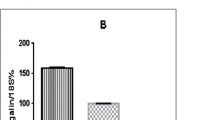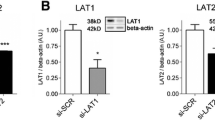Abstract
Purpose. To investigate the transport mechanism of valproic acid across the human placenta, we used human placental brush-border membrane vesicles and compared them with that of lactic acid.
Methods. Transport of [3H]valproic acid and [14C]lactic acid was measured by using human placental brush-border membrane vesicles.
Results. The uptakes of [3H]valproic acid and [14C]lactic acid into brush-border membrane vesicles were greatly stimulated at acidic extravesicular pH. The uptakes of [3H]valproic acid and [14C]lactic acid were inhibited by various fatty acids, p-chloromercuribenzene sulfonate, α-cyano-4-hydroxycinnamate, and FCCP. A kinetic analysis showed that it was saturable, with Michaelis constants (Kt) of 1.04 ± 0.41 mM and 1.71 ± 0.33 mM for [3H]valproic acid and [14C]lactic acid, respectively. Furthermore, lactic acid competitively inhibited [3H]valproic acid uptake and vice versa.
Conclusion. These results suggest that the transport of valproic acid across the microvillous membrane of human placenta is mediated by a proton-linked transport system that also transports lactic acid. However, some inhibitors differentially inhibited the uptakes of [3H]valproic acid and [14C]lactic acid, suggesting that other transport systems may also contribute to the elevated fetal blood concentration of valproic acid in gravida.
Similar content being viewed by others
REFERENCES
J. Stulc. Placental transfer of inorganic ions and water. Physiol. Rev. 77:805–836 (1997).
W. W. Hay Jr. Placental transport of nutrients to the fetus. Hormone Res. 42:215–222 (1994).
A. J. Moe. Placental amino acid transport. Am. J. Physiol. 268:C1321–C1331 (1995).
N. A. Reid and C. A. R. Boyd. Further evidence for the presence of two facilitative glucose transporter isoforms in the brush border membrane of the syncytiotrophoblast of the human full term placenta. Biochem. Soc. Trans. 22:267S (1994).
S. M. Grassl. Thiamine transport in placental brush border membrane vesicles. Biochim. Biophys. Acta 1371:213–222 (1998).
P. D. Prasad, H. Wang, R. Kekuda, T. Fujita, Y. Fei, L. D. Devoe, F. H. Leibach, and V. Ganapathy. Cloning and functional expression of a cDNA encoding a mammalian sodium-dependent vitamin transporter mediating the uptake of pantothenate, biotin, and lipoate. J. Biol. Chem. 273:7501–7506 (1998).
J. J. G. Marine, P. Bravo, M. Y. A. El-Mir, and M. A. Serrano. ATP-dependent bile acid transport across microvillous membrane of human term trophoblast. Am. J. Physiol. 268:G685–G694 (1995).
F. Ushigome, H. Takanaga, H. Matsuo, S. Yanai, K. Tsukimori, H. Nakano, T. Uchiumi, T. Nakamura, M. Kuwano, H. Ohtani, and Y. Sawada. Human placental transport of vinblastine, vincristine, digoxin and progesterone: contribution of Pglycoprotein. Eur. J. Pharm. 408:1–10 (2000).
G. M. Pacifici and R. Nottoli. Placental transfer of drugs administered to the mother. Clin. Pharmacokinetic Concept 28:235–269 (1995).
E. M. van der Aa, J. H. J. C. Peereboom-Stegeman, and G. M. Russel. Isolation of syncytial microvillous membrane vesicles from human term placenta and their application in drug-nutrient interaction studies. J. Pharmacol. Toxicol. Metods 34:47–56 (1995).
T. Ishizaki, K. Yokochi, K. Chiba, T. Tabuchi, and T. Wagatsuma. Placental transfer of anticonvulsants (phenobarbital, phenytoin, valproic acid) and the elimination from neonates. Pediatric Pharmacol. 1:291–303 (1981).
F. D. Malone and M. E. D'Alton. Drugs in pregnancy: anticonvulsants. Semin. Perinatol. 21:114–123 (1997).
M. S. Yerby. Teratogenic effects of antiepileptic drugs: what do we advise patients? Epilepsia 38:957–958 (1997).
S. R. Alonso de la Torre, M. A. Serrano, F. Alvarado, and J. M. Medina. Carrier-mediated L-lactate transport in brush-border membrane vesicles from rat placenta during late gestation. Biochem. J. 278:535–541 (1991).
D. F. Balkovetz, F. H. Leibach, V. B. Mahesh, and V. Ganapathy. A proton gradient is the driving force for uphill transport of lactate in human placental brush-border membrane vesicles. J. Biol. Chem. 263:13823–13830 (1988).
N. T. Price, V. N. Jackson, and A. P. Halestrap. Cloning and sequencing of four new mammalian monocarboxylate transporter (MCT) homologues confirms the existence of a transporter family with an ancient past. Biochem. J. 329:321–328 (1998).
S. Broer, H. P. Schneider, A. Broer, B. Rahman, B. Hamprecht, and J. W. Deitmer. Characterization of the monocarboxylate transporter 1 expressed in Xenopus laevis oocytes by changes in cytosolic pH. Biochem. J. 333:167–174 (1998).
I. Tamai, H. Takanaga, H. Maeda, Y. Sai, T. Ogihara, H. Higashida, and A. Tsuji. Participation of a proton-cotransporter, MCT1 in the intestinal transport of monocarboxylic acids. Biochem. Biophys. Res. Commun. 214:482–489 (1995).
C. H. Smith, D. M. Nelson, D. F. King, T. M. Donohue, S. M. Ruzycki, and L. K. Kelley. Characterization of a microvillous membrane preparation from human placental syncytiotrophoblast: a morphologic, biochemical and physiologic study. Am. J. Obstet. Gynecol. 128:190–195 (1977).
C. E. Hulstaert, J. L. Torringa, J. Koudstaal, M. J. Hardonk, and I. Molennaar. The characteristic distribution of alkaline phosphatase in full-term human placenta. Gynecol. Invest. 4:23–30 (1973).
N. Sawabu, M. Nakagen, T. Wakabayashi, K. Ozaki, D. Toya, N. Hattori, and M. Ishii. gamma-glutamyltranspeptidase as a tumor marker. Nippon Rinsho. 38:4606–4613 (1980).
O. H. Lowry, N. J. Rosebrough, A. L. Farr, and R. J. Randall. Protein measurement with the Folin phenol reagent. J. Biol. Chem. 193:265–275 (1951).
H. Iioka, I. Moriyama, M. Saito, K. Hino, Y. Okamura, and M. Ichijo. Study on changes in placental L-alanine transport activity during gestation. Nippon Sanka Fujinka Gakkai Zasshi 38:529–534 (1986).
F. G. M. Russel, P. E. M. van der Linden, W. G. Vermeulen, M. Heijn, C. H. van Os, and C. A. M. van Ginneken. Na+ and H+ gradient-dependent transport of p-aminohippurate in membrane vesicles from dog kidney cortex. Biochem. Phrmacol. 37:2639–2649 (1988).
B. Deuticke, E. Beyer, and B. Forst. Discrimination of three parallel pathways of lactate transport in the human erythrocyte membrane by inhibitors and kinetic properties. Biochim. Biophys. Acta 684:96–110 (1982).
B. Deuticke, E. Rickert, and E. Beyer. Stereoselective, pHdependent transfer of lactate in mammalian erythrocytes. Biochim. Biophys. Acta 507:137–155 (1978).
A. P. Halestrap and R. M. Denton. Specific inhibition of pyruvate transport in rat liver mitochondria and human erythrocytes by a-cyano-4-hydroxycinnamate. Biochem. J. 138:313–316 (1974).
R. C. Poole, A. P. Halestrap, S. J. Price, and A. J. Levi. The kinetics of transport of lactate and pyruvate into isolated cardiac myocytes from guinea pig. Biochem. J. 264:409–418 (1989).
R. C. Poole, S. L. Cranmer, A. P. Halestrap, and A. J. Levi. Substrate and inhibitor specificity of monocarboxylate transport into heart cells and erythrocytes. Biochem. J. 269:827–829 (1990).
R. C. Poole, S. L. Cranmer, D. W. Holdup, and A. P. Halestrap. Inhibition of L-lactate transport and band 3-mediated anion transport in erythrocytes by the novel stilbenedisulphonate N,N,N',N'-tetrabenzyl-4,4-diaminostilbene-2,2'-disulphonate (TBenzDS). Biochim. Biophys. Acta 1070:69–76 (1991).
R. C. Poole and A. P. Halestrap. Reversible and irreversible inhibition, by stilbenedisulphonates, of lactate transport into rat erythrocytes. Biochem. J. 275:307–312 (1991).
K. Yamaoka, Y. Tanigawara, T. Nakagawa, and T. Uno. A pharmacokinetic analysis program (MULTI) for microcomputer. J. Pharm-Dyn. 4:879–885 (1981).
N. L. C. L. Silva, H. Wang, C. V. Harris, D. Singh, and L. Fliegel. Characterization of the Na+/H+ exchanger in human choriocarcinoma (BeWo) cells. Pflugers Archiv Eur. J. Physiol. 433:792–802 (1997).
K. Nabuchi, I. Moriyama, M. Akasaki, Y. Katakami, H. Hisanaga, Y. Kato, and M. Ichijo. The study on the human placental L-lactate transport mechanism (using placental microvillous membrane vesicles). Nippon Sanka Fujinka Gakkai Zasshi 41:137–142 (1989).
K. D. K. Adkison and D. D. Shen. Uptake of valproic acid into rat brain is mediated by a medium-chain fatty acid transporter. J. Pharmacol. Exp. Ther. 276:1189–1200 (1995).
G. L. Edlund and A. P. Halestrap. The kinetics of lactate and pyruvate into rat hepatocytes. Biochem. J. 249:117–126 (1988).
A. Ritzhaupt, S. Wood, A. Ellis, K. B. Hosie, and S. P. Shirazi-Beechey. Identification and characterization of a monocarboxylate transporter (MCT1) in pig and human colon: its potential to transport L-lactate as well as butyrate. J. Physiol. 513:719–732 (1998).
S. Broer, A. Broer, H. P. Schneider, C. Stegen, and A. P. Halestrap. Characterization of the high-affinity monocarboxylate transporter MCT2 in Xenopus laevis oocytes. Biochem. J. 341: 529–535 (1999).
Author information
Authors and Affiliations
Corresponding author
Rights and permissions
About this article
Cite this article
Nakamura, H., Ushigome, F., Koyabu, N. et al. Proton Gradient-Dependent Transport of Valproic Acid in Human Placental Brush-Border Membrane Vesicles. Pharm Res 19, 154–161 (2002). https://doi.org/10.1023/A:1014242931475
Issue Date:
DOI: https://doi.org/10.1023/A:1014242931475




